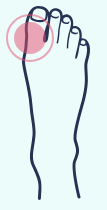
Bunions
Bunions are a very common condition that affects women significantly more than men due to poorly fitted footwear. A bunion is a bony protrusion that can occur at the base of the big toe joint. This bony lump can cause friction and pain when wearing shoes.
Bunions are frequently associated with inflammation of the bursa, a fluid-filled sac that helps cushion the bones of the foot. Another type of bunion, called a Tailor’s bunion or bunionette, forms on the outside of the foot on or at the base of the little toe joint. Smaller than a typical bunion, it is caused when the little toe is pressed in towards the big toe. With continued displacement of the big toe towards the smaller toes, a bunion can lead to the big toe resting under or over the second toe (a common condition called overlapping toes). It also can lead to a toe muscle deformity called hammer toes.
Symptoms, Causes and Common Treatments
Bunions

Symptoms
- Inflammation of the affected toe joint, foot and surrounding area
- Soreness of the big toe
- Discomfort or pain when walking or wearing shoes
- Callus formation under the protrusion
- Difficulty fitting into shoes
Causes
- Excessive rolling inward of the feet (over-pronation) while walking
- Various arthritic, genetic and neuromuscular diseases
- Abnormal foot function
- Improperly fitted shoes
- Wearing shoes with a smaller, constrictive or pointy toe box
Common Treatments
- In the early stages of bunion formation, soak feet in warm water
- Wear properly fitted shoes
- Wear bunion shields or bandages to limit progression and pain
- Choose shoes with a high, wide toe box
- Add arch supports to your shoes
- Wear rocker soled shoes to relieve pressure
- Wear night splints
- If left unaddressed, surgery may be necessary
Find your local store to speak to a Foot Solutions Expert
Foot Solutions Products
✔ Supportive athletic, casual or dress shoes
✔ Rocker soled shoes
✔ Night splints
✔ Custom-fitted, custom-crafted arch supports (orthotics)
✔ Over-the-counter arch supports (orthotics)

